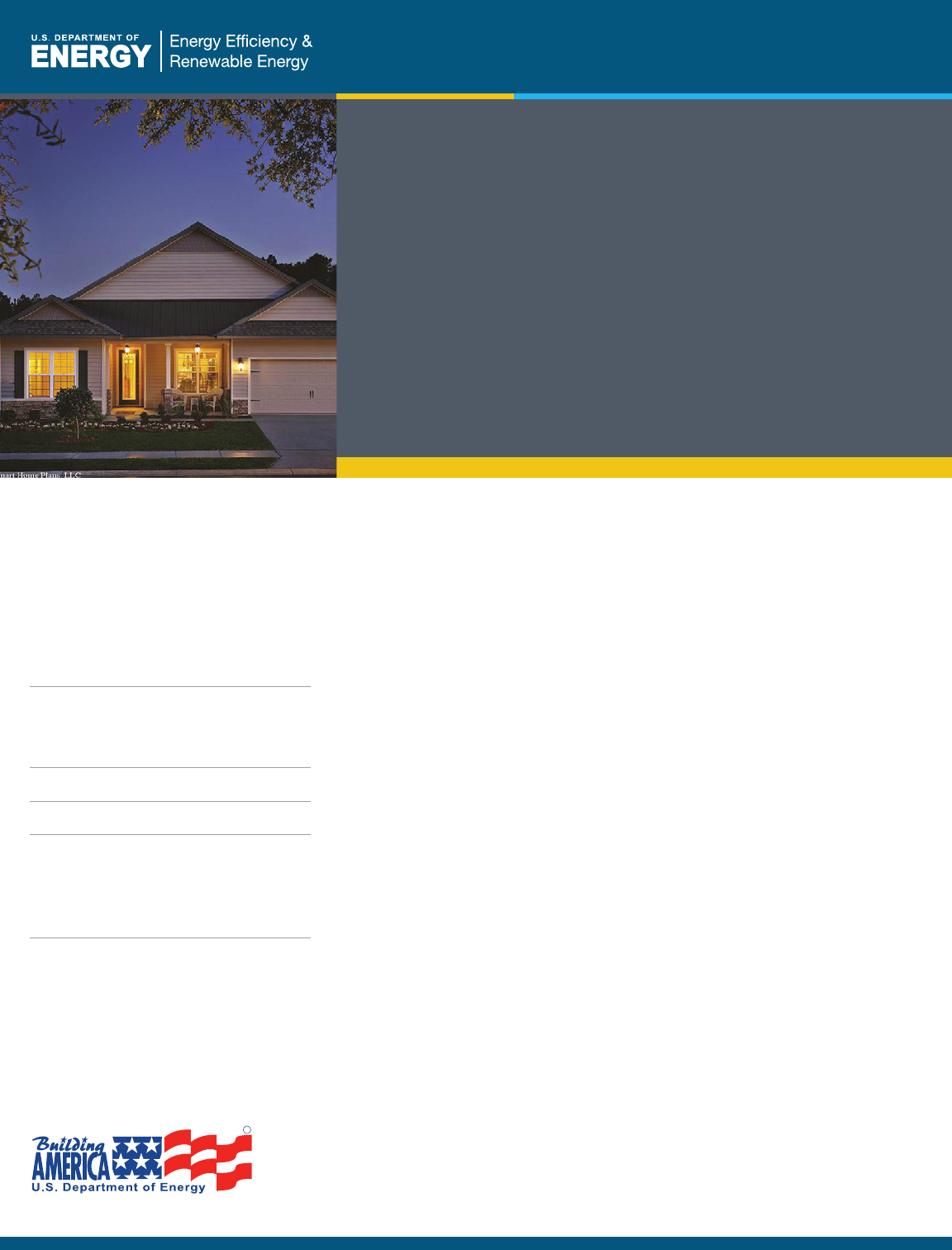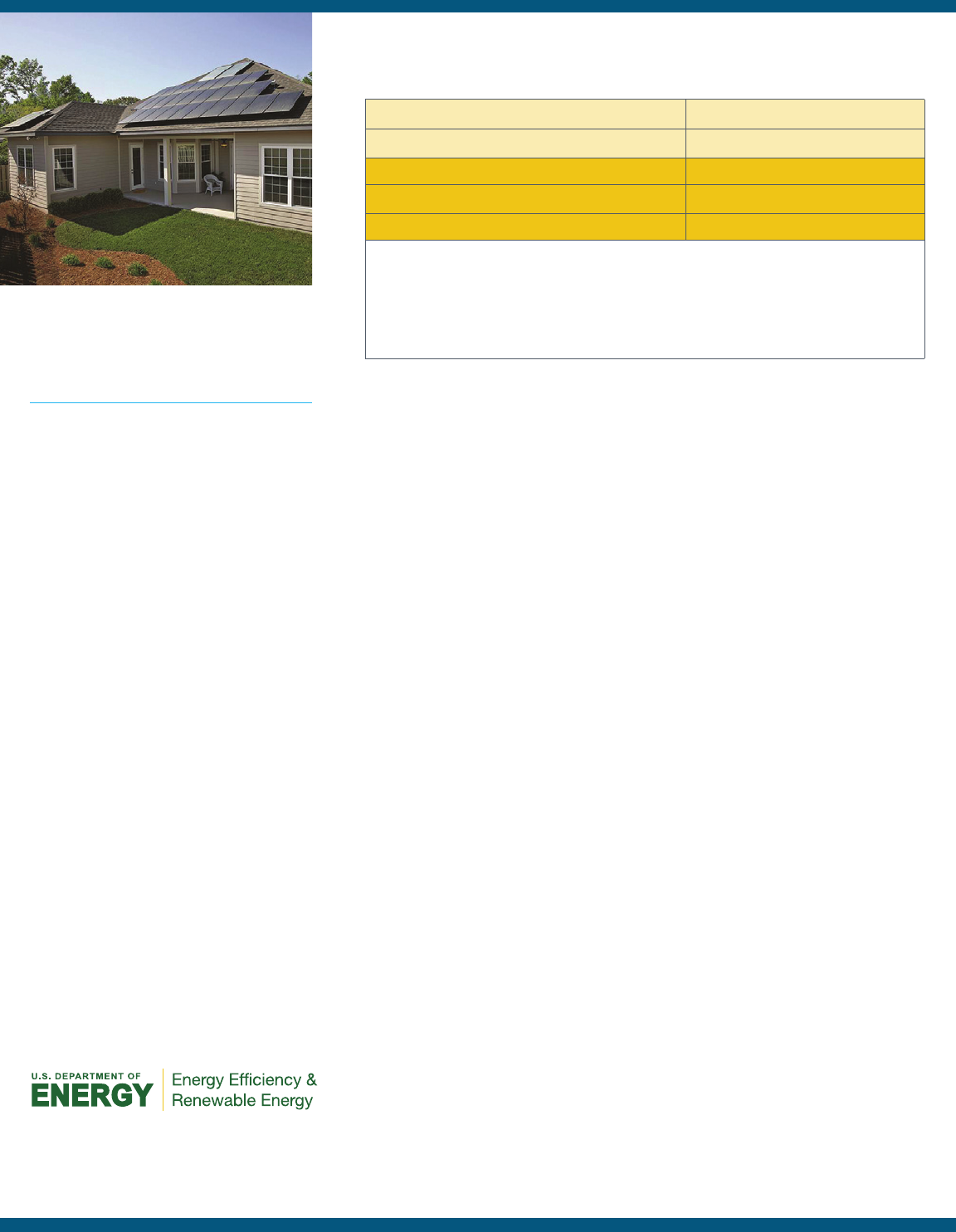
BUILDER PROFILE
Builder: Tommy Williams Homes
Gainesville, FL
www.tommywilliamshomes.com
Founded: 1978
Employees: 11
Development: Belmont (136 homes)
and Longleaf Village (275 homes)
1,470 to 3,045 ft
$190,000 to $370,000
Construction Date: 2007-2011
“The market has spoken. Energy efciency sells,” said Todd Louis,
vice-president of Tommy Williams Homes in Gainesville, Florida. Since
partnering with the U.S. Department of Energy’s Building America
program in 2004, Tommy Williams’ production homes have outsold
the competition, with sales increasing year after year in spite of the
recession. The key, Louis said, is the systems-engineering approach that
produces high levels of energy efciency, comfort, and indoor air quality.
The company is so condent in its homes’ energy savings that it offers to
pay the buyer’s energy bill for the rst year.
In 2010 Tommy Williams built 36 homes, and every one has a Home
Energy Rating System (HERS) score under 60. By comparison, a home
built to minimum Florida code will have a HERS score as high as 85.
The company’s expertise was developed in partnership with Florida
HERO, an energy consulting rm, and other members of the Building
America Industrialized Housing Partnership. The team provided
systems engineering support, energy simulations with cost data, and
hands-on construction education.
“Building high-performance homes is not expensive,” said Florida
HERO president Ken Fonorow. “In fact, these methods are so cost-
effective that there’s absolutely no reason for a builder to build a less
energy-efcient home.”
Energy-Efficiency Features
Tommy Williams’ homes are in the Longleaf Village and Belmont
developments in the hot-humid climate of Gainesville, Florida. The
one- and two-story homes have three to ve bedrooms, range from
1,470 to 3,045 ft², and sell for $190,000 to $370,000.
BUILDING TECHNOLOGIES PROGRAM
Tommy Williams Homes, a production builder
in Gainesville, Florida, built 36 homes in 2010,
all of which achieved HERS scores under 60.
The Building America Industrialized Housing
Partnership has worked with Tommy Williams
Homes since 2004 to meet the company’s
goal of building high-performance, energy-
ecient homes.
Building America Best Practices Series
Volume 15. Builders Challenge Guide to 40% Whole-House
Energy Savings in the Hot-Humid Climate
Case Study:
Tommy Williams Homes
Gainesville, FL
R

The tight thermal envelope in Tommy Williams’ homes is achieved with
walls and attics that are sealed and insulated. Wall cavities of the 2x4
16-inch on-center framed walls are lled with R-15, formaldehyde-free,
blown berglass insulation. Ladder T framing creates extra room
for insulation. A foam gasket is used to seal the air gap between the
drywall and top plate of the walls. Holes around pipes and wiring in
the exterior walls are sealed with expanding foam. The vented attic has
R-30 blown-in insulation with kneewall air barriers, foam gaskets, and a
radiant barrier on the underside of the roof decking. Blower-door tests
show 2.7 air changes per hour at 50 Pascals.
Because a hot, humid climate can pose air quality problems, the HVAC
system must be carefully designed. Since air conditioning removes
humidity in summertime, the air conditioner must be sized correctly for
the home, said Fonorow of Florida HERO. An overly large system will
cool the home and cycle off too quickly, allowing humidity to build up.
Tommy Williams Homes used ACCA Manual J to size the SEER 16,
HSPF 9.5 heat pump with a MERV 8 air lter.
In the wintertime, humidity problems are caused by internally generated
moisture from cooking and bathing. The problem is solved in Tommy
Willams’ homes with a positive pressure ventilation system in which
drier outdoor air is drawn to the return side of the air handler,
downstream from the return air lter. The system supplies fresh air only
when the air handler is running. When fresh air is introduced, Fonorow
said, the positive pressure in the house pushes stale air out of the home.
For additional humidity control, bathroom fans are equipped with a
moisture sensor. The fans
run automatically, venting
moist air to the outside, until
the humidity is reduced to a
set point.
Louis said the positive
pressure ventilation system
has been used successfully
for more than a decade,
but too few builders take
advantage of it.
The houses’ ducts, sized according to ACCA Manual D, are sealed
with mastic at joints and located in the attic. The attic’s radiant barrier
protects the cool air in the ducts from heat gain in the hot, humid
climate. Duct tests show 4% air leakage at 25 Pascals. Tommy Williams
is working on designs that move the ducts into conditioned space.
Tommy Williams uses covered porches to protect the large window
areas from solar heat gain. The low-emissivity vinyl-framed windows
are U=0.35, SHGC=0.25. Energy savings also come from a tankless gas
water heater that is 0.83 EF.
(Top) Tommy Williams Homes uses
formaldehyde-free blown fiberglass
insulation for R-15 in the walls and R-30
in the attics.
(Bottom) Fresh air intakes are installed in
the roof sot or porch ceiling and ducted
to the air handler’s return plenum to bring
filtered fresh air to the house.
“There isn’t a person in the
country who is not interested
in having a lower energy bill.
It costs less to spend a few
thousand dollars up front and
have a lower utility bill for the
life of the home.”
TODD LOUIS
Vice-President, Tommy Williams Homes
BUILDING AMERICA BEST PRACTICES SERIES
2

Building America partner Florida HERO conducts midpoint and nal
inspections on every home built by Tommy Williams. In addition to duct
leakage and blower door tests, the independent consultant conducts
the ENERGY STAR thermal bypass inspection and pressure mapping.
Florida HERO also measures the mechanical ventilation ow, the supply
air ow, the HVAC system static pressure, and temperature differences
across the HVAC coil exhaust.
Health, Durability, Sustainability
All of Tommy Williams’ homes meet or exceed the standards for
ENERGY STAR certication and certication by the Florida Green
Building Coalition. The builder uses zero-VOC paint. The duct board is
anti-microbial. Moisture-resistant brick and ber-cement siding add to
the homes’ durability.
Innovation
“The most important innovation we use is taking a whole house
approach,” Louis said. “We’re not just giving customers a few energy-
efcient options to choose from like low-e windows, the radiant barrier,
the interior duct system, or advanced framing techniques. We’re putting
them all together to create a much better home.”
The company’s innovations don’t stop there. Tommy Williams has worked
with the Building America team BAIHP to build two net-zero-energy
homes with photovoltaic panels and solar hot water systems. The homes
have a HERS score of -2, which means they produce more energy than
they consume. The company is constructing a third zero-energy home
and has developed a set of net-zero-energy “ready made” home plans.
“These homes are becoming more affordable,” Louis said. He expects
to see “a tipping point coming very soon where we’ll be selling more
zero-energy homes than standard homes. It’s just the right thing to do
for our kids and grandkids.”
Dollars and Sense
The energy-efcient features of a Tommy Williams home increase its
cost, on average, by about $3,300, compared to a similar home built to
minimum Florida code. When nanced as part of a 30-year mortgage,
this means a cost to the homeowner of about $265 a year. But the
reduction in energy bills averages $930 a year. The buyer wins.
To underscore how low the home’s energy bill will be, Tommy Williams
Homes offers to pay it for the rst year. “This is more than a sales
incentive,” said Louis. “It tells customers that we stand behind our
energy-efcient features.”
Energy-Efficient Features
• HERSscores:48-58
• Foundation:Slab-on-grade
• Siding:Brickandbercement
• Wallinsulation:R-15,formaldehyde-
free, blown fiberglass
• Attic:Radiantbarrier,R-30blown-in
insulation, kneewall air barriers, foam
gasket sealing
• HVAC:ACCAManualJsizing,
variable speed air handler, SEER 16,
HSPF 9.5 heat pump
• Ventilation:Fresh-air,intaketothe
returnsideoftheairhandler,MERV8
air filter, moisture-sensor-controlled
exhaust fans
• Ductsystem:ACCAManualDsized,
anti-microbial duct board, mastic
sealed
• Waterheating:Tanklessgas,0.83EF
• Windows:Low-E,double-pane
insulated vinyl windows, U=0.35,
SHGC=0.25
• Lighting:100%CFL
• Appliances:ENERGYSTAR
dishwasher
3
CASE STUDY: TOMMY WILLIAMS HOMES

Table 1. Calculated Costs and Savings of Energy-Efficiency
Features for Tommy Williams Homes, Gainesville, Florida
Total Energy Savings vs. Benchmark
1
42%
TotalAddedBuilderCost
2
$3,314
Annual Utility Bill savings $930
AnnualMortgagePaymentIncrease
2, 3
$265
AnnualNetCashFlowtotheHomeowner $665
1
Savings are in comparison to the Building America benchmark (a home built to the 1993 Model
Energy Code)
2
Builder costs were estimated by builders and Building America team. Costs include a 10%
markup. Incentives and rebates are not included.
3
Mortgage costs are based on a 30-yr fixed mortgage at 7% interest; inflation is not considered.
The Bottom Line
Tommy Williams Homes has proven to buyers that they can save
money and have a better home, Louis said. Sales gures conrm this.
In Longleaf Village, Tommy Williams and a competitor each own half
of the 550 lots. But Tommy Williams’ houses are selling faster. In 2010,
Tommy Williams sold 23 homes in the development, the competitor just
16, even though the energy-efciency features of a Tommy Williams
house mean a higher price per square foot – $139.13 compared to the
competitor’s $126.34. Clearly, customers are willing to pay extra for the
benets of a high-performance, energy-efcient home.
For Fonorow, what’s most exciting is that Tommy Williams Homes
demonstrates unequivocally that companies can build production homes
with HERS scores in the 50s and utility bills under $100 a month using
off-the-shelf products, installed by standard contractors. “And Tommy
Williams Homes has reaped the rewards of increased sales and quicker
turnaround times,” said Fonorow.
For More Information
www.buildingamerica.gov
EERE Information Center
1-877-EERE-INF (1-877-337-3463)
eere.energy.gov/informationcenter
PNNL-SA-78346 September 2011
Tommy Williams Homes’ first zero energy
homewascompletedinJanuary2010
and had a tested HERS score of -2.
Tommy Williams Homes’
Recipe for High-Performance
Homes in a Hot-Humid Climate
• Createatightthermalenvelope.
• Installapositivepressure
ventilation system.
• Right-sizetheHVACequipment
and duct system.
• Placetheairhandlerin
conditioned space.
• Designthehousewithpassive
strategies to reduce solar heat gain.
• Installlow-emissivitywindows.
• Employindependenttestingfor
qualityassurance.
BUILDING AMERICA BEST PRACTICES SERIES
4
